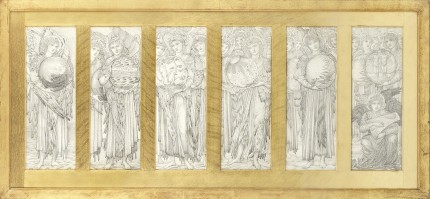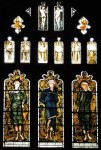
A complete framed series of six highly detailed pencil drawings by Victorian artist Sir Edward Burne-Jones depicting the days of creation is coming up for auction for the first time in 40 years. The Days of Creation painting is considered one of Burne-Jones’ greatest works, and this pencil drawing is more than just a study for the later masterpiece. There are distinct differences between the painting and the drawing. It’s a fully realized exhibited work in its own right.
Burne-Jones made the drawings around 1871 during a period of withdrawal from public exhibition. The year before he had stormed off when the Society of Painters in Water-Colours asked him to modify a painting of Phyllis and Demophoön which was deemed a little too spicy to display as is because the mainly naked Phyllis was clearly recognizable as model Maria Zambaco, his lover and the daughter of his patron. Also she was embracing Demophoön in a manner that suggested more sexual hunger that Victorian womanhood was supposed to evince. He refused to make the change and withdrew from the exhibition and from the society.
 For the next seven years he stopped showing his work but he never stopped working. In 1870 he designed six stained glass windows for his old Oxford friend and frequent collaborator William Morris. This was his first exploration of this version of The Days of Creation idea. Each of the six windows featured an angel with a flame on his forehead holding a globe depicting God’s actions on that day — the separation of light from dark, separation of the waters, and so forth. As the days progress, the number of angels increased to match. Morris & Co. turned Burne-Jones’ designs into stained glass and they were installed in the west window of All Saints Church, Middleton Cheney, Northamptonshire.
For the next seven years he stopped showing his work but he never stopped working. In 1870 he designed six stained glass windows for his old Oxford friend and frequent collaborator William Morris. This was his first exploration of this version of The Days of Creation idea. Each of the six windows featured an angel with a flame on his forehead holding a globe depicting God’s actions on that day — the separation of light from dark, separation of the waters, and so forth. As the days progress, the number of angels increased to match. Morris & Co. turned Burne-Jones’ designs into stained glass and they were installed in the west window of All Saints Church, Middleton Cheney, Northamptonshire.
 The pencil drawings are similar to the stained glass in concept and iconography, but are more complex and detailed. We know from a note in his work-record that he began the drawings in 1871. In 1872, he began work on the paintings, a gouache watercolor with shell gold and platinum paint on linen panels more than twice the size of the pencil drawings. He worked on the paintings off and on through 1876. Once completed, the panels were framed in a huge Renaissance revival contraption designed by Burke-Jones specifically to hold all six Days.
The pencil drawings are similar to the stained glass in concept and iconography, but are more complex and detailed. We know from a note in his work-record that he began the drawings in 1871. In 1872, he began work on the paintings, a gouache watercolor with shell gold and platinum paint on linen panels more than twice the size of the pencil drawings. He worked on the paintings off and on through 1876. Once completed, the panels were framed in a huge Renaissance revival contraption designed by Burke-Jones specifically to hold all six Days.
 In May of 1877, Edward Burne-Jones exhibited The Days of Creation painting in his comeback show at Grosvenor Gallery in London. It was a sensation. Oscar Wilde went to the Grosvenor Gallery show, describing his visit in detail in an article for Dublin University Magazine (the essay is included in his book of collected writings, Miscellanies). He critiqued works on display by the likes of Sir John Everett Millais and Sir Lawrence Alma-Tadema before lingering on Burne-Jones’ triumphant return with The Days of Creation, The Beguiling of Merlin, and the Mirror of Venus. Here’s his description of The Days of Creation:
In May of 1877, Edward Burne-Jones exhibited The Days of Creation painting in his comeback show at Grosvenor Gallery in London. It was a sensation. Oscar Wilde went to the Grosvenor Gallery show, describing his visit in detail in an article for Dublin University Magazine (the essay is included in his book of collected writings, Miscellanies). He critiqued works on display by the likes of Sir John Everett Millais and Sir Lawrence Alma-Tadema before lingering on Burne-Jones’ triumphant return with The Days of Creation, The Beguiling of Merlin, and the Mirror of Venus. Here’s his description of The Days of Creation:
The next picture is divided into six compartments, each representing a day in the Creation of the World, under the symbol of an angel holding a crystal globe, within which is shown the work of a day. In the first compartment stands the lonely angel of the First Day, and within the crystal ball Light is being separated from Darkness. In the fourth compartment are four angels, and the crystal glows like a heated opal, for within it the creation of the Sun, Moon, and Stars is passing; the number of the angels increases, and the colours grow more vivid till we reach the sixth compartment, which shines afar off like a rainbow. Within it are the six angels of the Creation, each holding its crystal ball; and within the crystal of the sixth angel one can see Adam’s strong brown limbs and hero form, and the pale, beautiful body of Eve. At the feet also of these six winged
messengers of the Creator is sitting the angel of the Seventh Day, who on a harp of gold is singing the glories of that coming day which we have not yet seen. The faces of the angels are pale and oval-shaped, in their eyes is the light of Wisdom and Love, and their lips seem as if they would speak to us; and strength and beauty are in their wings. They stand with naked feet, some on shell-strewn sands whereon tide has never washed nor storm broken, others it seems on pools of water, others on strange flowers; and their hair is like the bright glory round a saint’s head.
![]() The painting was considered a triumph. Burne-Jones’ Renaissance influences (particularly Michelangelo and Mantegna) and clean style moved him out of the orbit of his early mentor pre-Raphaelite Dante Gabriel Rossetti, and placed Burne-Jones firmly at the head of the burgeoning Aesthetic movement. Days was so popular that stained glass versions of it were commissioned by a variety of churches for years even after Burne-Jones’ death. Morris & Co made a neat version in Della Robbia ware ceramic between 1893 and 1906 for Dyfrig Chapel at Llandaff Cathedral in Cardiff, Wales.
The painting was considered a triumph. Burne-Jones’ Renaissance influences (particularly Michelangelo and Mantegna) and clean style moved him out of the orbit of his early mentor pre-Raphaelite Dante Gabriel Rossetti, and placed Burne-Jones firmly at the head of the burgeoning Aesthetic movement. Days was so popular that stained glass versions of it were commissioned by a variety of churches for years even after Burne-Jones’ death. Morris & Co made a neat version in Della Robbia ware ceramic between 1893 and 1906 for Dyfrig Chapel at Llandaff Cathedral in Cardiff, Wales.
The painting went through various private hands until its last owner, Grenville Winthrop, bequeathed it to Harvard’s Fogg Art Museum in 1943. The series remained on display in Cambridge for the next 47 years. It was on loan in a dining room in Dunster House at Harvard University in 1970 when the fourth panel was stolen. It is still missing today. The surviving five panels are still at the Fogg Art Museum.
 That makes this series of pencil drawings even more important. They’re complete and framed together as Burne-Jones’ intended. Their ownership history is also illustrious. Their first owner was Aglaia Coronio, a friend, model and muse of Burne-Jones’ who probably received the drawings as a gift from the artist. After her suicide in 1906, her niece Zoë Ionides purchased the drawings from the estate before they could be put up for auction. The first time they came up for sale on the public market was 1973, after Zoë’s death. It was bought by an art gallery who sold it to the mother of the present owner who of course wishes to remain anonymous.
That makes this series of pencil drawings even more important. They’re complete and framed together as Burne-Jones’ intended. Their ownership history is also illustrious. Their first owner was Aglaia Coronio, a friend, model and muse of Burne-Jones’ who probably received the drawings as a gift from the artist. After her suicide in 1906, her niece Zoë Ionides purchased the drawings from the estate before they could be put up for auction. The first time they came up for sale on the public market was 1973, after Zoë’s death. It was bought by an art gallery who sold it to the mother of the present owner who of course wishes to remain anonymous.
The Days of Creation drawing will be sold at Bonhams in London on January 23rd. The pre-sale estimate is $340,000 – $400,000.